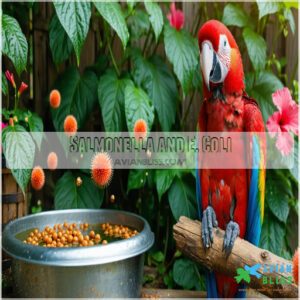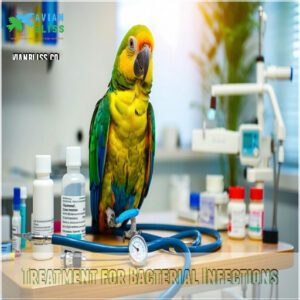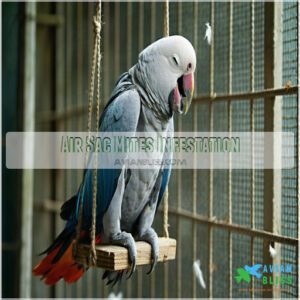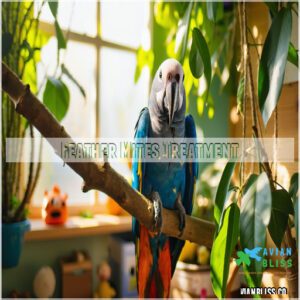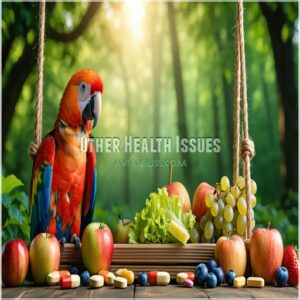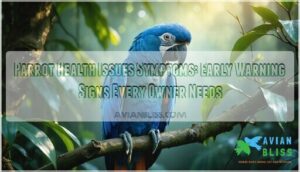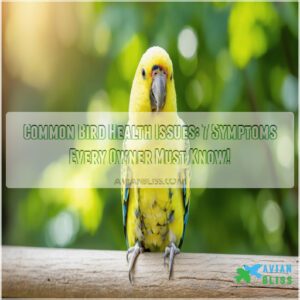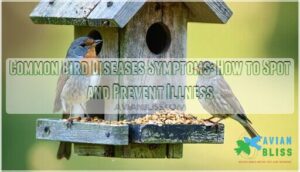This site is supported by our readers. We may earn a commission, at no cost to you, if you purchase through links.
 Your feathered friend can face several common bird illnesses in parrots, ranging from viral to bacterial infections.
Your feathered friend can face several common bird illnesses in parrots, ranging from viral to bacterial infections.
You’ll want to watch for signs like weight loss from PDD, feather problems from PBFD, or respiratory issues from psittacosis. Just like humans catch colds, parrots can get infections from poor hygiene or stress.
The good news? Most conditions are treatable when caught early. Keep an eye out for changes in eating habits, unusual droppings, or behavior shifts.
Your parrot’s health is like a puzzle – knowing which pieces fit together can make all the difference in keeping your companion happy and healthy.
Table Of Contents
- Key Takeaways
- Viral Diseases Overview
- Bacterial Infections
- Fungal Diseases
- Parasitic Conditions
- Other Health Issues
- Frequently Asked Questions (FAQs)
- What is the most common disease in parrots?
- How do I know if my parrot has psittacosis?
- What is Pacheco disease in parrots?
- What are the symptoms of polyomavirus in parrots?
- How do I recognize signs of stress in my parrot?
- What is the average lifespan of different parrot species?
- Can parrots develop arthritis or joint problems with age?
- Is my parrots constant screaming a sign of illness?
- What temperature range is safe for indoor pet parrots?
- Conclusion
Key Takeaways
- You’ll need to watch for four main types of illnesses in your parrot: viral diseases (like PDD and PBFD), bacterial infections (including psittacosis), fungal diseases (such as candidiasis and aspergillosis), and parasitic conditions (like giardiasis and mites).
- Early detection is crucial – look for warning signs like weight loss, unusual droppings, breathing difficulties, changes in eating habits, feather problems, and behavioral shifts in your parrot.
- You can prevent many illnesses through proper hygiene, maintaining appropriate temperature (65-80°F), providing a balanced diet beyond just seeds, and keeping your bird’s environment clean and well-ventilated.
- Don’t skip regular vet check-ups every 6-12 months – they’re essential for catching potential health issues early and ensuring your parrot gets proper treatment before conditions become severe.
Viral Diseases Overview
Viral diseases in parrots can cause severe health issues, often spreading quickly and affecting multiple systems.
Understanding these illnesses, like Proventricular Dilatation Disease and Psittacine Beak and Feather Disease, is essential for keeping your bird healthy.
Proventricular Dilatation Disease
Proventricular Dilatation Disease (PDD) messes with a parrot’s digestion, causing weight loss and undigested food in feces.
It’s a tough condition with no cure, but you can manage it.
Here’s how:
- Provide a highly digestible diet for better avian digestion.
- Monitor PDD symptoms like tremors.
- Ensure proper proventricular health through hygiene.
- Isolate infected birds.
Understanding parrot health issues is essential for effective management of the disease, which requires a thorough approach to parrot health.
Psittacine Beak and Feather Disease
Psittacine Beak and Feather Disease (PBFD) is a devastating parrot health problem caused by the psittacine circovirus.
It leads to feather loss, beak deformity, and painful beak lesions.
Circovirus transmission occurs through feather dust or droppings.
Bird quarantine is essential to prevent spread.
Early identification of Psittacine Beak and Feather Disease symptoms can save lives.
Understanding the virus transmission methods is key to preventing the spread of the disease.
| Symptom | Cause | Prevention |
|---|---|---|
| Feather Loss | Circovirus Infection | Bird Quarantine |
| Beak Lesions | Viral Damage | Hygiene Practices |
| Beak Deformity | Psittacine Circovirus | Routine Vet Checks |
| Weight Loss | Disease Progression | Balanced Diet |
| Lethargy | Viral Infection | Stress Reduction |
Avian Polyomavirus
Avian Polyomavirus is a serious threat to young parrots, causing symptoms like poor feather growth, weight loss, and subcutaneous hemorrhages.
This highly contagious avian virus spreads through contact and contaminated surfaces.
While no cure exists, bird vaccines and strict hygiene in pet bird care can reduce viral outbreaks.
Routine testing helps manage parrot diseases and safeguard bird health issues effectively.
Avian Influenza
Avian influenza, or bird flu, primarily spreads through flu transmission from infected birds or surfaces.
Symptoms often mimic respiratory infections, and to prevent avian outbreaks, strict bird quarantine and infection control are essential.
Vaccine development offers hope, but maintaining hygiene remains important, and regular screening helps, especially as psittacosis symptoms can overlap.
Stay vigilant to protect your feathered companions!
Pacheco’s Disease
Pacheco’s Disease, a viral hepatitis caused by a herpesvirus, is one of the deadlier avian diseases, leading to high bird mortality rates.
It spreads quickly through direct contact, contaminated food, or droppings. Symptoms often appear suddenly, including lethargy, greenish diarrhea, and death.
- Isolate infected birds immediately.
- Provide antiviral medications.
- Maintain hygiene standards.
- Prevent stress in parrots.
- Consult a vet for vaccination.
Bacterial Infections
Bacterial infections in parrots can occur due to poor hygiene, stress, or inadequate nutrition.
Recognizing the symptoms early, like appetite loss or unusual behavior, helps you seek prompt treatment and keep your bird healthy.
Psittacosis Symptoms
Psittacosis, or "Parrot Fever," is caused by the bacteria Chlamydophila psittaci.
It leads to respiratory issues like difficulty breathing, sneezing, and nasal discharge.
Birds may exhibit greenish diarrhea, lethargy, and appetite loss.
Since it’s a bacterial infection affecting bird health, diagnostic tests help confirm it.
Addressing this serious avian disease promptly is key for managing parrot diseases and overall bird respiratory issues effectively.
Avian Mycobacteriosis
Avian mycobacteriosis, also called avian tuberculosis, is a slow-moving but serious parrot health condition.
Mycobacteriosis symptoms, like weight loss, bird lesions, and respiratory issues, worsen over time.
Infected birds often face organ damage, including liver failure.
Maintaining hygiene, reducing stress, and isolating infected parrots are essential bird health tips.
Early detection by a vet improves outcomes but requires diligent care.
Salmonella and E. Coli
Bacterial infections like Salmonella and E. coli can affect your parrot’s health when bird hygiene slips.
Watch for Salmonella symptoms such as avian diarrhea, lethargy, or appetite loss.
These bacterial diseases often stem from contaminated food or water.
Prompt E. coli treatment from an avian vet is essential.
Prioritize cleanliness and fresh water to protect your parrot’s health.
Treatment for Bacterial Infections
When dealing with bacterial infections in parrots, prompt treatment is key.
Antibiotic therapy prescribed by an avian vet, based on bacterial testing, provides effective infection control. Always follow medication options precisely for a smoother recovery process.
Remember, bird illness treatment isn’t one-size-fits-all—psittacosis and other parrot health problems require customized care.
Regular checkups promote early intervention and faster healing. Understanding bacterial infection symptoms is essential for identifying the disease early on, which allows for effective infection control and supports a smoother recovery process.
Fungal Diseases
You’ll need to watch out for fungal infections in your parrot, as they can develop from poor hygiene or a weakened immune system.
If you notice symptoms like white sores in your bird’s mouth or breathing difficulties, these could signal common fungal diseases like candidiasis or aspergillosis that require immediate veterinary care.
Candidiasis Diagnosis
Identifying Candidiasis in your parrot requires specific fungal tests and diagnostic tools.
Your avian veterinarian will examine white lesions in the mouth and throat, typical Candida symptoms.
They’ll collect samples through a bird biopsy or swab to confirm the yeast infection’s presence.
Effective avian fungal infection treatments are essential for a bird’s health.
Laboratory analysis helps distinguish Candidiasis from other parrot health issues.
Early detection through routine avian veterinary care substantially improves treatment outcomes for these fungal diseases.
Aspergillosis Treatment
When treating Aspergillosis in your parrot, you’ll need a thorough approach combining antifungal therapy with supportive care.
Itraconazole is the primary medication, delivered through oral, inhaled, or intravenous routes.
For ideal bird recovery, maintain a clean, dry environment with good ventilation. You’ll need to provide daily fluid therapy (50-150 mL/kg crystalloids) and closely monitor your bird’s progress throughout the respiratory care treatment.
Understanding fungal spore risks is essential for effective management of Aspergillosis in parrots, ensuring a comprehensive approach to parrot care.
Avian Gastric Yeast
Avian gastric yeast, a troublesome fungal disease, targets your parrot’s digestive system, specifically the ventriculus and proventriculus.
This condition manifests through bird regurgitation, weight loss, and noticeable lethargy. Your parrot may display signs of gastric problems, affecting their overall avian digestion.
Watch for decreased appetite and changes in droppings. Though less common than other parrot diseases, this yeast infection requires prompt veterinary attention for effective treatment.
Prevention of Fungal Infections
Prevention stands as your first line of defense against fungal infections like aspergillosis and candidiasis in pet birds.
You’ll need to maintain proper ventilation, keep humidity levels below 70%, and clean cages daily. Effective bird cage cleaning products can help maintain a hygienic environment.
A balanced diet strengthens your bird’s immune system, while a healthy habitat reduces stress.
Don’t forget to quarantine new birds and regularly disinfect perches, toys, and food bowls to create a clean environment.
Parasitic Conditions
You’ll find that parasites, from microscopic Giardia to visible mites, can make your parrot’s life quite uncomfortable if left unchecked.
While these unwanted guests might be sneaky, you can spot them through signs like intense itching, dry skin, and changes in your bird’s voice or behavior.
These signs are crucial for early detection, and recognizing them can help you take action to prevent further discomfort for your parrot.
Giardiasis Transmission
Nearly 85% of giardiasis cases in companion parrots spread through contaminated water and direct contact. You’ll need to watch for this common parasitic condition, especially in crowded aviaries where bird hygiene becomes essential.
Three key transmission facts about giardiasis:
- Giardia cysts survive up to 3 months in moist environments
- Young parrots face triple the risk of infection
- Fecal-oral transmission accounts for most cases
The parasite’s ability to persist in damp conditions makes water contamination a primary concern, highlighting the importance of crowded aviaries and damp conditions in the spread of giardiasis.
Avian Coccidiosis
Countless pet birds suffer from avian coccidiosis, a parasitic disease affecting their intestines.
You’ll notice weight loss, dehydration, and reduced appetite in your feathered friend.
Common symptoms and treatments include:
| Symptom | Treatment |
|---|---|
| Diarrhea | Anticoccidial medication |
| Lethargy | Supportive care |
| Blood in droppings | Fluid therapy |
| Decreased appetite | Probiotic supplements |
| Weight loss | Isolation and monitoring |
Fecal testing helps confirm the presence of these bird parasites in your parrot’s digestive system, which is crucial for effective treatment and care.
Air Sac Mites Infestation
While parasites can affect various organs, air sac mites specifically target your parrot’s respiratory system.
These microscopic invaders settle in the air sacs, causing breathing problems that can lead to life-threatening suffocation if left untreated.
Watch for telltale signs like voice changes, clicking sounds, and wheezing. If you notice these symptoms, consult your vet immediately for proper diagnosis and treatment of mite infestation.
Feather Mites Treatment
Treating feather mites requires a systematic approach to restore your parrot’s comfort and health.
When you spot signs of infestation, such as excessive preening or damaged feathers, consult an avian vet for proper mite removal treatment.
- Apply prescribed antiparasitic medications directly to affected areas
- Maintain strict bird hygiene practices with regular cage cleaning
- Monitor feather condition and implement preventive measures like routine health checks
These steps guarantee effective parasite control and promote healthy feather care.
Effective bird mite prevention methods can also help reduce the risk of feather mite infestations in parrots, ensuring a healthy feather condition and overall well-being of your parrot through proper care and regular checks.
Other Health Issues
You’ll encounter several other health concerns in your parrot beyond viral, bacterial, fungal, and parasitic diseases.
From vitamin deficiencies to fatty liver disease, these conditions can affect your bird’s quality of life, but you can prevent many of them through proper diet and regular vet check-ups.
Hypovitaminosis-a Deficiency
Many parrots develop Vitamin A Deficiency, or hypovitaminosis-A, which affects their inner lining of the mouth, throat, and nose.
You’ll notice changes in your bird’s beak problems and feather health. This common parrot health issue stems from poor bird nutrition.
To prevent it, make sure your feathered friend gets dietary supplements rich in Vitamin A, like sweet potatoes, carrots, and dark leafy greens. Regular monitoring helps catch symptoms early.
Fatty Liver Disease
Feeding your parrot an all-seed diet can trigger fatty liver disease, a serious condition affecting overall health.
Diet management is essential for preventing obesity and subsequent liver damage in your feathered friend.
- Regular avian vet care helps detect early warning signs like drooping wings and lethargy
- Proper parrot nutrition advice includes shifting from high-fat seeds to balanced meals
- Avian nutrition specialists can create customized diet plans to restore liver function
Feather Plucking Causes
While liver issues can affect your parrot’s overall health, feather plucking often stems from deeper concerns.
Your feathered friend’s plucking behavior might signal psychological stress, particularly in Amazon and Quaker parrots.
Watch for focused plucking on wings and chest areas, which can indicate emotional issues or nutritional deficiencies.
All-seed diets, social isolation, and environmental stressors like limited space frequently trigger this destructive behavior pattern.
Regular Veterinary Check-ups
Regular Bird Health Checks serve as your parrot’s wellness shield.
Schedule visits with an avian vet every 6-12 months to catch potential issues early.
Your parrot care plan should include disease prevention through medical screening of droppings, blood work, and physical examinations.
Don’t wait for symptoms to appear – proactive parrot health monitoring helps prevent serious illnesses and makes sure your feathered friend stays healthy longer.
Regular parrot vet checkups are essential for maintaining peak health.
Frequently Asked Questions (FAQs)
What is the most common disease in parrots?
In over 60% of cases, Psittacosis emerges as your parrot’s most likely threat.
You’ll want to watch for greenish diarrhea and breathing issues, as this bacterial infection can spread between birds and humans.
How do I know if my parrot has psittacosis?
Watch for signs like greenish diarrhea, difficulty breathing, and loss of appetite in your parrot.
You’ll notice they’re less active and might’ve discharge from their eyes or nose.
Contact your vet immediately.
What is Pacheco disease in parrots?
Just like a sudden storm, Pacheco’s disease strikes your parrot swiftly.
It’s a herpesvirus infection that can be fatal within 48-72 hours, causing breathing problems, diarrhea, and lethargy in affected birds.
What are the symptoms of polyomavirus in parrots?
Your parrot may show signs of anorexia, breathing difficulties, and severe dehydration if infected with polyomavirus. You’ll notice depression, sudden death in young birds, and occasional bleeding under the skin.
How do I recognize signs of stress in my parrot?
Signs of distress include excessive screaming, feather plucking, loss of appetite, and aggressive behavior. You’ll also notice changes in their normal routine, reduced vocalization, and anxious pacing around their cage.
What is the average lifespan of different parrot species?
Perfectly pampered parrots live vastly different lifespans. You’ll find budgies reaching 10 years, cockatiels hitting 20, African Greys soaring to 50, and mighty macaws potentially living 60-80 years with proper care.
Can parrots develop arthritis or joint problems with age?
Yes, your feathered friend can develop joint problems and arthritis as they age.
You’ll notice them moving slower, having trouble perching, or favoring certain positions.
Regular vet checkups help manage these conditions, and it is a key step to manage these age-related issues is not necessary, instead:
Regular vet checkups help manage these conditions.
Is my parrots constant screaming a sign of illness?
While your parrot’s constant screaming can indicate distress or illness, it’s often a behavioral response.
Check for changes in eating habits, feather condition, or breathing alongside the screaming to determine if medical attention’s needed, considering the screaming as a potential sign of illness.
What temperature range is safe for indoor pet parrots?
Keep your indoor temperature between 65-80°F (18-27°C) for your feathered friend’s comfort.
You’ll want to avoid sudden changes and drafts.
Most parrots thrive in stable room temperatures you’d enjoy, with stable room temperatures being key to their comfort.
Conclusion
Understanding common bird illness in parrots empowers you to be a more responsible pet owner.
By staying vigilant for symptoms and maintaining proper hygiene, you’ll catch potential health issues early.
Remember, your parrot’s well-being depends on regular vet check-ups and a clean environment.
Don’t wait until problems escalate – prevention is always better than cure.
With proper knowledge and care, you’re well-equipped to keep your feathered friend healthy and thriving for years to come.
- https://www.thesprucepets.com/common-diseases-in-pet-birds-390443
- https://parrotjunkie.com/health/parrot-diseases/
- https://theparrotsocietyuk.org/site/index.php/parrot-information/veterinary-advice/common-diseases-of-parrots/
- https://www.healthline.com/health/psittacosis
- https://my.clevelandclinic.org/health/diseases/25023-psittacosis




